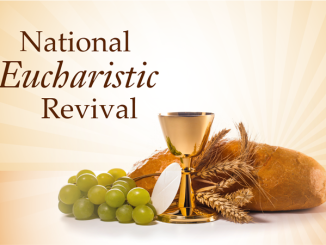This is the sixth article in a series about forming children for active participation in the Mass.
Polls show that many Catholics don’t believe in the Real Presence of Jesus Christ in the Eucharist. If so many adults don’t understand it, how can catechists help children to learn this and take it to heart?
Begin with Catechists
Catechists should be encouraged to live the Real Presence by receiving Eucharist regularly, learning about its meaning, and participating in Adoration. There is simply no substitute for authentic belief when catechizing others.
The Divine Friend
When introducing young children to the life of Jesus, catechists should give special attention to the Paschal Mystery: Jesus’ Crucifixion, Death, Resurrection (and Ascension). Children should learn that Jesus is God come down to earth in a real human body, but now his glorified body allows him to be in Heaven and with us too. If children understand that he is different from human friends, they are less likely to be literal about his flesh and blood.
When preparing students for Eucharist, explain that Jesus wants to keep us close and wants us to become more like him. When we receive Holy Communion, Christ becomes a part of our spirits, just as the bread and wine, as real food, become part of our bodies. At the Last Supper he said, “This IS my body… This IS my blood.” Teach that “is” means this is really true—spiritually—even though the Eucharist looks and tastes like bread and wine. Always answer questions as well as possible, but share with children that this is a mystery!
The Reserved Eucharist
Teach the meaning and function of the tabernacle: Jesus Christ is in the bread leftover from Mass, kept to be taken to the sick people of the parish and to keep Jesus present in the church. Expect them to genuflect and act respectfully to honor his presence.
As soon as children are old enough to stay still, introduce them to Adoration. If you don’t have a Eucharistic chapel, ask your pastor to expose the Blessed Sacrament for the children. Prepare children by explaining that Jesus wants them to spend time with him. A period of 15 to 20 minutes of quiet time with Jesus several times throughout the year should be a good introduction for children.
The Mass
Help older children learn about transubstantiation through the prayers of the Mass. First, teach that during the Eucharistic Prayer, when the priest holds his hands over the bread and wine, he calls down the Holy Spirit to change them into the Body and Blood of Christ. Second, teach that the Prayer after Communion tells what the Church is asking God to do for us through the Eucharist we have just received. Try having students reflect or journal on the words from the Roman Missal each week. Help them see that the power of Christ’s presence in the Eucharist can help them experience personal growth, and that’s why they should continue receiving Eucharist throughout their lives.





I am so delighted that The Real Presence of Jesus is being revealed to our children. Praise God.
I am teaching 3 rd grade Ccd . Focus this year is on the rosary but I’m wanting a simple explanation for Real Presence. This helped🌸💕✝️